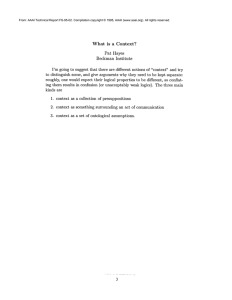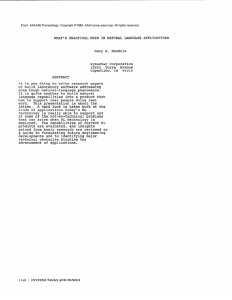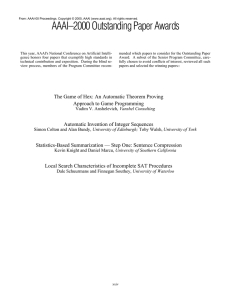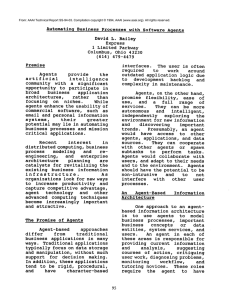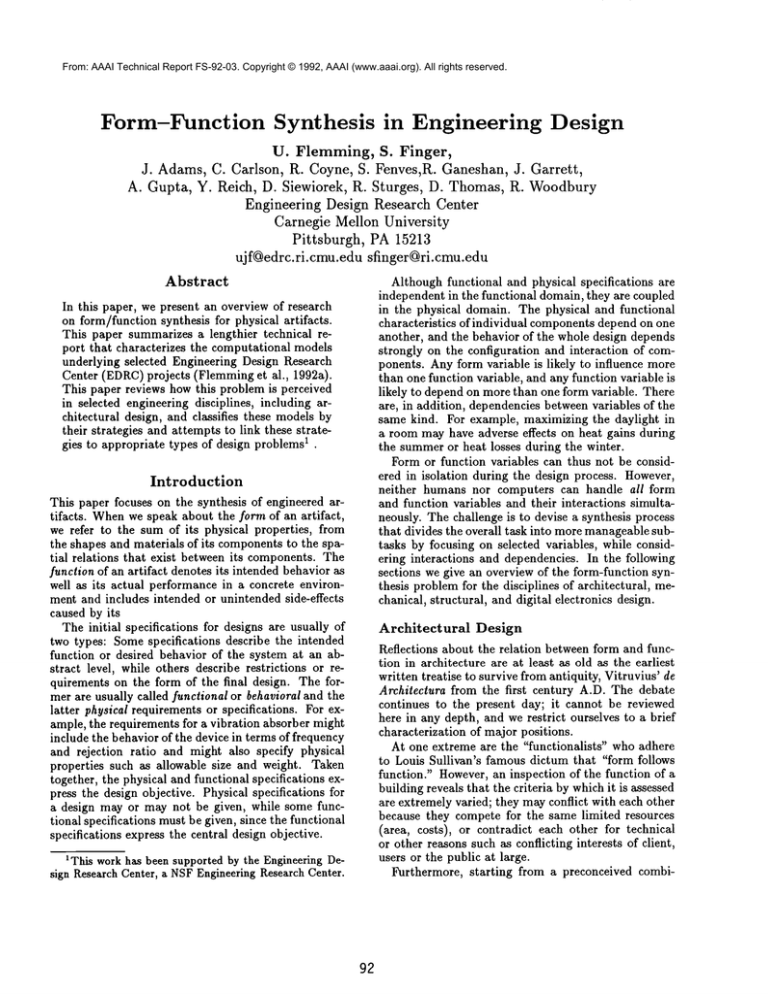
From: AAAI Technical Report FS-92-03. Copyright © 1992, AAAI (www.aaai.org). All rights reserved.
Form-Function
Synthesis
in Engineering
Design
U. Flemming,
S. Finger,
J. Adams, C. Carlson, R. Coyne, S. Fenves,R. Ganeshan, J. Garrett,
A. Cupta, Y. Reich, D. Siewiorek,
R. Sturges,
D. Thomas, R. Woodbury
Engineering
Design Research Center
Carnegie Mellon University
Pittsburgh,
PA 15213
ujf@edrc.ri.cmu.edu
sfinger@ri.cmu.edu
Although functional and physical specifications are
independent in the functional domain, they are coupled
in the physical domain. The physicM and functional
characteristics of individual componentsdepend on one
another, and the behavior of the whole design depends
strongly on the configuration and interaction of components. Anyform variable is likely to influence more
than one function variable, and any function variable is
likely to depend on more than one form variable. There
are, in addition, dependencies between variables of the
same kind. For example, maximizing the daylight in
a room may have adverse effects on heat gains during
the summeror heat losses during the winter.
Form or function variables can thus not be considered in isolation during the design process. However,
neither humans nor computers can handle all form
and function variables and their interactions simultaneously. The challenge is to devise a synthesis process
that divides the overall task into more manageablesubtasks by focusing on selected variables, while considering interactions and dependencies. In the following
sections we give an overview of the form-function synthesis problem for the disciplines of architectural, mechanical, structural, and digital electronics design.
Abstract
In this paper, we present an overview of research
on form/function synthesis for physical artifacts.
This paper summarizes a lengthier technical report that characterizes the computational models
underlying selected Engineering Design Research
Center (EDRC)projects (Flemming et al., 1992a).
This paper reviews how this problem is perceived
in selected engineering disciplines, including architectural design, and classifies these models by
their strategies and attempts to link these strategies to appropriate types of design problems1 .
Introduction
This paper focuses on the synthesis of engineered artifacts. Whenwe speak about the form of an artifact,
we refer to the sum of its physical properties, from
the shapes and materials of its componentsto the spatial relations that exist between its components. The
function of an artifact denotes its intended behavior as
well as its actual performance in a concrete environment and includes intended or unintended side-effects
caused by its
The initial specifications for designs are usually of
two types: Somespecifications describe the intended
function or desired behavior of the system at an abstract level, while others describe restrictions or requirements on the form of the final design. The former are usually called functional or behavioral and the
latter physical requirements or specifications. For example, the requirements for a vibration absorber might
include the behavior of the device in terms of frequency
and rejection ratio and might also specify physical
properties such as allowable size and weight. Taken
together, the physical and functional specifications express the design objective. Physical specifications for
a design may or may not be given, while some functional specifications must be given, since the functional
specifications express the central design objective.
Architectural
Design
Reflections about the relation between form and function in architecture are at least as old as the earliest
written treatise to survive from antiquity, Vitruvius’ de
Architectura from the first century A.D. The debate
continues to the present day; it cannot be reviewed
here in any depth, and we restrict ourselves to a brief
characterization of major positions.
At one extreme are the "functionalists" who adhere
to Louis Sullivan’s famous dictum that "form follows
function." However,an inspection of the function of a
building reveals that the criteria by which it is assessed
are extremely varied; they mayconflict with each other
because they compete for the same limited resources
(area, costs), or contradict each other for technical
or other reasons such as conflicting interests of client,
users or the public at large.
Furthermore, starting from a preconceived combi-
1This work has been supported by the Engineering Design Research Center, a NSFEngineering Research Center.
92
From: AAAI Technical Report FS-92-03. Copyright © 1992, AAAI (www.aaai.org). All rights reserved.
nation of functional characteristics is difficult because
often it is not clear at the outset what types of components may be involved in a design. In the Kimball
Art Museumin Fort Worth, Texas (designed by Louis
Kahn), for example, the roof structure consists of a series of beams with a curved cross section, two of which
can be combinedto form a vault that lets light in from
the top and diffuses it in combination with a suspended
screen, which also diffuses sound. Thus two components perform structural, lighting and acoustic functions in addition to playing a major role in the overall
architectural composition. Wecan imagine alternative
solutions in which the same functions are performed by
different types, even different numbers of components;
e.g. light diffusion maybe provided by skylights that
are not part of the roof structure. Thus, mappings
from function to form are generally not unique, and
a straight-forward functional determinism appears not
only undesirable, but impractical.
The other extreme in the form/function debate is occupied by architects for whomthe form of a building is
its only interesting aspect and who"build against function", as the architect Philip Johnson put it. This position may appear incomprehensible to observers outside
the circles in which these debates take place; but the
very fact that it can be formulated at all points out
that the relation between a building and its function
may be rather loose indeed. This is demonstrated by
the high degree of adaptability to varying uses that
buildings have shown over time.
Attempts to systematize and formalize architectural
design in connection with computer-aided design tend
to favor someform of generate-and-test; that is, they
assume that a design must be specified to a certain
level of completeness before it can be evaluated. This
solves some of the problems created by the complex
interactions between form and function: It is generally
easier to evaluate a design according to multiple criteria and to discover conflicts than to develop a design
directly from multiple and conflicting criteria.
Evenif inferences from function to form are generally
difficult in architectural design, certain research directions appear underexplored. Not every design problem requires the invention or novel assembly of components. For certain recurring combinations of functional
requirements, prototypical component configurations
are known. They could be retrieved from a properly
constructed database and parametrically adjusted in
accordance with a specific situation, including the systematic variation of form variables via the variation of
function variables (Finger &Rinderle, 1990).
like?" Indeed, most mechanical design CADsystems
are based on the assumption that the design proceeds
from geometry. That is, CADsystems enable designers
to create and manipulate the geometry of a design and
then to analyze it for the required behaviors.
To create a mechanical part, a designer transforms
an abstract functional description for a device into a
physical description that satisfies the functional requirements. In this sense, design is a transformation
from the functional domain to the physical domain;
however, the criteria for selecting appropriate transformations and methods for accomplishing transformations are not well understood. Design transformations
in circuits, software and some architectural applications lead to a degree and type of modularity not well
suited to mechanical devices (Rinderle, 1986).
Good mechanical designs are often composed of
highly-integrated, tightly-coupled components, where
the interactions amongthe components are essential
to the behavior and economy of the design. This assertion runs counter to methodologies in engineering
fields such as software design and circuit design that
result in designs in whicheach componentfulfills a single function with minimal interaction. Because of the
geometry, weight, and cost of mechanical components,
converting a single behavioral requirement into a single componentis often both impractical and infeasible.
Each component may contribute to several required
behaviors, and a single required behavior may involve
many components. In fact, most mechanical components perform not only the desired behavior, but also
many additional, unintended behaviors. In a good designs, these additional behaviors are often exploited.
Because of the difficulties of representing behaviors
and their interdependencies, most mechanical designers begin by generating the geometric form of the artifact and then analyzing, for example, its structural,
thermal, and kinematic behaviors. This observation
can be verified by examining the available mechanical
CADpackages. In all of them, the designer synthesizes
the artifact by interactively creating the geometry and
then invokes analysis tools to check whether the artifact meets its requirements; if it does not, the designer
changes the geometry and repeats the cycle.
Finding useful representations for function and behavior for mechanical artifacts is difficult because
of the coupling of behavior and form in mechanical parts. Only a few domains within mechanical
engineering, such as kinematics, have standard representations that are used in design synthesis. For
example, the Transformation Project presented in
(Finger & Rinderle, 1990) begins with a bond graph
representation for the behavioral requirements of a
gear train. The bond graph representation captures
only the requirements for power flow; other requirements must be stated in terms of constraints. Manyof
the requirements can be analyzed only after the gear
train has been synthesized.
Mechanical
Engineering
The designer of mechanical parts often moves directly
from a statement of functional requirements to sketches
of the artifact that will meet those requirements. Experienced designers can answer the question: "Given the
functional requirements, what should the artifact look
93
From: AAAI Technical Report FS-92-03. Copyright © 1992, AAAI (www.aaai.org). All rights reserved.
Structural
Engineering
The role of structural engineering is, typically, to take
the overall form of an artifact determined by other considerations and elaborate it into the detailed form of a
structural configuration and its componentsto satisfy
functional requirements of strength, safety, serviceability, etc. The overall form maybe derived from formal
or spatial considerations (e.g., the massingof a building or shape of an automobile), from functional considerations (e.g., the geometric layout of a crossing to be
bridged dictated by traffic flow), or a combination of
the two (e.g., the layout of a ship or aircraft dictated
by both the spatial layout of the cargo and the fluid
flow around it).
Structural design deals with the determination of
the detailed form of the structural load-resisting system. The determination of the overall form is affected
by the incorporation of structural functionality considerations. Thus, the form/function "debate" occurs
at two levels. One level concerns the overall form of
the structure: Is it driven by spatial considerations
or by its load-carrying function? An elegant example
of the latter is Eiffel’s design for his 300-metertower:
the slope of the legs at any level is such that the axial forces acting along the legs intersect the resultant
of the wind loads above that level; thus, there is no
bending anywhere, resulting in a very efficient structure. Weakerforms of function-driven form are Fazlur
Khan’s Hancock building in Chicago, hyperbolic cooling towers, and most long-span bridges. In most cases,
however, function is subordinate to form: Architects,
plant designers, or highwaylayout engineers define the
overall form, and structural engineers provide the best
function they can within the spatial constraints.
The second level concerns the physical form of the
structure: Which function determines the form? Typically, a structural system is an assembly of discrete
components, each providing multiple functionalities.
The strength of a wall may be dictated by gravity and
load resistance functions and its stiffness by drift limitation (comfort) function. That same wall may, furthermore, serve as an architectural separation, as a
thermal and noise barrier, and as a conduit for electrical and mechanical utilities. At this level, structural
design is closely related to mechanical and architectural design, in that each componentmust satisfy several functional requirements, and each functional requirement is satisfied by several components.
Form-functionsynthesis in structural design is inherently a multi-level process, whereeach level contributes
to someelaboration or refinement of the physical structure satisfying (or optimizing) a variety of functional
requirements. The components may be concrete (e.g.,
a beamor wall) or abstract (e.g., a 3-D frame), and
functional requirements may be intrinsic to the loadcarrying function (e.g., strength and stiffness) or extrinsic to it (e.g., spatial demands). In the synthesis
of a structural system, which invariably interacts with
other formal or b ehavioral functionalities of the overall
artifact, function-to-form transformations are as likely
to occur as form-to-function transformations.
Digital
Electronics
Design
In digital electronics design, the designed artifact is
composedof an interconnection of pins on various components such as transistors, gates, macrocells, chips, or
boards. The form of the artifact is considered at two
distinct levels of detail: logical form, whichdoes not include geometric information, and physical form, which
includes geometric information. Digital electronics designers have three well-accepted perspectives of the design: function or behavior, structure, and geometry.
The mapping from function to structure is called logical design, and the mapping from structure to geometry is physical design. Someform variables (e.g. board
size and the set of available components) are provided
as constraints to the synthesis process.
Physical design consists of two subtasks: placement
and routing. In placement, a library of geometric information is used to dimension components, which are
positioned on an area of specified dimensions to satisfy a numberof possibly conflicting goals. These goals
include increasing routability of the interconnections,
reducing signal cross talk, and reducing heat dissipation levels; usuMly the primary goal is minimizing the
total interconnection distance. The problems of placement and routing are intimately related; however, historically they have been treated separately due to the
inherent computational complexity of the problem.
The synthesis of form in logical design occurs at
three levels: logic synthesis, behavioral synthesis,
and system-level synthesis. In logic synthesis, a set
of Boolean expressions and finite state machines is
mapped into an interconnection of gates and memory
devices. Generating a structure that satisfies the specified function is a relatively straightforward procedure.
The difficulty is in optimizing the form for a set of
criteria (e.g. least size or least time delays).
In behavioral synthesis, an algorithmic description of
a portion of a computer, such as a CPU,is mappedinto
an interconnection of register transfer elements, such
aa ALUs,registers, multiplexors, and buses. Finding
feasible solutions to subtasks is relatively simple, but
the search for optimal solutions is NP-complete. Even
though the components are modular and fulfill a single function, a good design makes maximal use of each
component. For example, one component can perform
the same function on different operands. Heuristic
algorithms that generate near-optimal solutions have
been developed. The SAWsystem encapsulates a set
of these algorithms (Thomaset al., 1990).
In system-level synthesis, a set of high-level functional requirements (e.g. instruction set or clock speed)
is transformed into an interconnection of chips (e.g.
processors, memory,peripheral chips, transceivers, and
latches). At this level, generating a feasible solution is
94
From: AAAI Technical Report FS-92-03. Copyright © 1992, AAAI (www.aaai.org). All rights reserved.
diffficult because the mappingfrom functional requirements to an interconnection of chips is not well understood. The MICONsystem (Birmingham et al., 1992)
uses a knowledge-based approach in which the mapping is provided incrementally by a humantrainer.
Whilethe goals of these synthesis tasks are different,
they have several commoncharacteristics. In each, the
design space is large, ruling out brute-force generateand-test approaches. In addition, no good evaluators
exist for partially designed artifacts; thus, incremental
generate-and-test is not suitable. Noneof the steps has
a single objective; rather, each pursues several competing objectives so that many pareto-optimal solutions
exist. Furthermore, the design space is discrete and
discontinuous due to, for example, step functions in
memorysizes.
the same level of granularity and produce a complete
structure only at the end.
A third class uses strategies that start with a highlystructured description and perform transformations on
this structure until a sufficiently detailed physical specification has been found. The transformations themselves may include refinement or constructive operations. Wecall these approaches middle-out strategies,
although our use of this term is not entirely the same
as that in the AI planning literature.
Wecan add additional stratifications to this classification by observing that within each strategy, one of
two contrasting inference mechanisms may be at work:
from function to form or from form to function, which
correspond roughly to goal- and data-driven processes.
In the following sections, we characterize these strategies and emphasize their prerequisites and the characteristics of the design problems for which they show
promise.
Discussion
These disciplines share a core of concerns that center around three related sets of issues: 1) Functional
specifications normally do not mapuniquely into component configurations. A large space of alternatives is
available, and the structure of this space is often ill-understood and precludes the employmentof standard
search strategies. 2) The search for alternatives is complicated by the multifunctionality of componentsor by
the fact that single-function components can be used
in multiple ways. This makesit difficult to concentrate
at any given time on a single functional characteristic
or behavior aspect and thus eliminates some obvious
problem decompositions. 3) Functional characteristics
mayconflict with each other. Therefore, tradeoffs must
be taken into account, complicating the evaluations
performed during synthesis and making optimization
difficult to integrate into this process.
Amongthe disciplines reviewed here, digital electronics design has come closest to an accepted decomposition of an overall design problem into more manageable subproblems. Mechanical engineering appears
to occupy the other extreme: it has a particular need
for developing a theoretical base for formal specifications of behavior and function/form transformations.
Top-Down or Refinement
Strategies
~Mnction-Driven Strategies
This strategy
is
demonstrated by the model underlying the Conceptual
Design project (Sturges & Kilani, 1990), which proceeds by decomposingan initial overall goal or function statement recursively into conjunctions of goals
or objectives until physical componentscan be selected
directly to satisfy a subgoal. Alternative refinements
may exist at any level, and the resulting hierarchy
need not be strict; e.g. a component may satisfy more
than one objective. This type of goal refinement is
also represented by the recording mechanismunderlying the Design Intent project (Ganeshan et al., 1991),
which uses a refinement strategy that generalizes the
approach used by (Garrett & Fenves, 1986). MICON
also performs function-driven refinement; however, it
refines parts not functions or objectives. Weinclude
it in the present class of strategies because the refinements are clearly function- or specification-driven.
An important prerequisite for top-down functiondriven strategies is that knowledgeabout possible refinements be accessible. The first two projects rely on
interactions with designers for this purpose and provide an interactive recording mechanismthat reflects
a particular formal model of the design process. The
benefit is that neither project depends on pre-stored
knowledge, that is, on routine situations or repetitive
design problems. MICONalso provides a mechanism
to elicit refinement knowledge when needed from experts through its tutoring component. Thus, a knowledge base for automated refinements is built graduMly
over many problem runs. Any refinement hierarchy
represents explicitly the couplings between goals and
subgoals or between goals and components. Global
interactions across goals or components must be handled by evMuations after selections have been made.
We call such global evaluation mechanisms that are
invoked after decisions have been made critics.
Classification
The approaches underlying the EDRCprojects fall naturally into three broad classes. The first of these encompasses top-down or refinement strategies, in which
an overall description of an artifact or design objective
is elaborated through several levels of abstraction until
a sufficiently detailed specification has been achieved.
A second and contrasting class is formed by bottomup strategies, which are also sometimescalled constructive strategies. These strategies construct the physical
structure of an artifact in a step-wise fashion at the
same level of abstraction. The refinement strategies
attempt to generate structures that are complete relative to the granularity associated with that level; the
bottom-up strategies, in contrast, work more or less at
95
From: AAAI Technical Report FS-92-03. Copyright © 1992, AAAI (www.aaai.org). All rights reserved.
Form-Driven Strategies
Form-driven refinement
strategies implementpart refinement through levels of
abstraction. In contrast to function-driven strategies,
the refinement is driven more by given part decompositions than by behavior specifications, although the latter maybe important for selecting refinements. Global
interactions again are handled by critics. This strategy is typically employed when the problem specification consists mainly of physical specifications that suggest at least good guesses about appropriate classes of
component configurations. An example are the physical specifications from which BRIDGER
(Reich, 1992)
starts (required length, traffic volume,site characteristics). Each part can be viewedas defining a goal or objective: that of finding a refinement into less abstract
subparts that satisfy the specifications associated with
it. The Design Intent approach therefore can also work
for form-driven refinement strategies.
Grammar-based approaches are applicable to formdriven refinement when the refinements are context-directed, where context is the current state of the design. This is particularly
easy when the grammars
use a represenation that is appropriate for any abstraction level. For example, a rectangular solid representing a partition at one level of abstraction can
be refined into an internal frame covered by plaster
board, where each refined component is again represented as a geometric solid. Some of the grammars that have been written in GENESIS can be
viewed in this way (Heisserman, 1991); another example are the decompositions employed by ABLOOS
(Coyne & Flemming, 1990). These processes reflect
the progression through scales that characterizes e.g.
building design.
The difficulties that arise with this strategy are
similar to those mentioned in the preceding section.
Knowledgeabout appropriate refinements must be accessible and pre-stored, which restricts applications to
routine situations or assumes interactions with the designer. BRIDGER
is an interesting third possibility: a
system able to learn from its ownexperience.
Bottom-Up
or Constructive
non-linear programming (MINLP) problem. This suggests that MINLPapproaches generally can be subsumed under the present strategy, a connection that
we cannot pursue further in the present paper.
The coupling between form and function variables is
explicit and tighter than in any other strategy. One of
the advantages of the approach is that interactions are
taken into account automatically by the constraint satisfaction technique. A disadvantage is that it requires
an explicit listing of all possible waysof satisfying the
constraints in advance. Another problem is generic to
the bottom-up strategies: the combinatorial explosion
of the search space as the problems involve large numbers of objects or constraints.
Form-Driven Strategies
Form-driven strategies
include the classical hierarchical
or incremental
generate-and-test
approaches as used by LOOSand
other grammar-based systems. A prerequisite is that
solutions can be constructed incrementally and that
intermediate evaluations can be carried out with some
certainty. Another, more fundamental, prerequisite is
that the constructions guarantee that every promising
solution can, in principle, be generated; this may require a considerable amount of theory formation. Since
these mechanisms can be developed independent of the
tests to be executed, the coupling between form and
function variables can remain loose, which is one reason for the generality or flexibility of the approach. On
the other hand, the search space tends to explode with
the number of objects and forces functional concerns
to be considered as early and effectively as possible. In
(Flemming et al., 1992b), we present a more detailed
comparison between WRIGHTand LOOS.
Middle-Out
Strategies
Function-driven
Strategies
These strategies
become possible when a highly-structured description of
behavior is given that can be transformed into a logical or physical design by associating physical components with the elements in the behavior specification.
"Highly-structured" means that the behavior specification contains an explicit representation of the interactions between behavioral components, which allows the transformations to be governed mainly by
local constraints or specifications and eliminates, in
the ideal case, the need for global critics. Both SAW
and the Transformation Project use a graph representation: a Verilog description in the first case and a
bond graph in the second case. This strategy depends
for its success on two rather stringent prerequisites.
An appropriate behavior description must be given at
the outset. Equally important is the availability of
behavior-preserving transformations, a decidedly nontrivial requirement as demonstrated by the Transformation Project.
Strategies
Function-Driven
Strategies
Bottom-up or constructive strategies build the description of an artifact
through a sequence of decisions which occur at the lowest, most detailed level. The WRIGHT
project demonstrates that a bottom-up approach can be functiondriven (Baykan & Fox, 1991). WRIGHT
solves layout
problems by examining the constraints to be satisfied
and builds a solution by satisfying one constraint at a
time. This requires that all constraints be expressed
uniformly as equations or inequalities in the form variables (in this case, the coordinates of the objects to
be allocated) and that the structural alternatives that
exist for solving any constraint be explicitly stored as a
disjunct of constraints. The problem formulation generated by WRIGHT
is equivalent to a mixed integer
Form-Driven Strategies
Form-driven middle-out
strategies are conceivable, albeit not represented by
96
From: AAAI Technical Report FS-92-03. Copyright © 1992, AAAI (www.aaai.org). All rights reserved.
any of the projects here. Instead of starting with a
highly-structured behavior description, they start with
a highly-structured form description. Manyof the prototype refinement strategies discussed in the literature
fit this description. They retrieve solution prototypes
from a database and adjust them to a given context or
problem specification by "parameter tweaking"; that
is, the structure of the prototype is preserved in contrast to the refinement strategies that gradually expand a structure through levels of abstraction and the
bottom-up approaches that construct it from its constituent
elements. ARCHPLAN,
a component of the
IBDE system developed at the EDRC,implements aspects of this approach (Schmitt, 1988).
Challenges
and Future
ligence in Engineering V. Vol 1: Design, edited by J.
Gero, Springer, York, 1990, pp. 91-111.
Finger, S. and Rinderle, J. R., "TransformingBehavioral
and Physical Representations of MechanicalDesigns", in:
Proceedings of the First International Workshop on
Formal Methods in Engineering Design, Manufacturing, and Assembly, Colorado State University, January
15-17, 1990, pp. 133-151.
Flemming,U., Adams,J., Carlson, C., Coyne, R., Fenves,
S., Finger, S., Ganeshan,R., Garrett, J., Gupta,A., Reich,
Y., Siewiorek, D., Sturges, R., Thomas,D., and Woodbury,
R., "Computational Modelsfor Form-FunctionSynthesis in
Engineering Design", Technical Report, no. EDRC
12-5292, EDRC,Carnegie Mellon, Pittsburgh, PA, March1992.
Work
Flemming, U., Baykan, C., Coyne, R. F., and Fox, M.,
"Hierarchical Generate-and-Test vs. Constraint-Directed
Search. A Comparisonin the Context of Layout Synthesis", in: Artificial Intelligence in Design’92,edited by J.
Gero, Kluwer AcademicPublishers, 1992.
Aside from specific challenges faced by individual
projects, several general challenges emerge from our
survey. Foremost is the challenge to test a model’s
applicability for realistic problems. This is less a challenge for the models developed for digital electronics
design, which have for the most part passed that test.
But the majority of projects described in this paper are
still in a highly experimental stage and must be tested
in the context of more realistic
problems. Another
interesting test would be to apply particular models
across domains,
These two types of tests or experiments are likely
to increase our understanding of the salient characteristics of the underlying models and their relations
to the characteristics of generic design problems. The
overview presented in the preceding section should only
be seen as a first step towards a more detailed and substantive classification.
Issues of usability and integration of the capabilities offered by successful models into general designsupport environment will have to be addressed: What
are the roles of the humanand computational agents
involved and how can they evolve through use and
time? What are the desired types of interactions? Is
there a generic set of interaction types, or are they
idiosyncratic to a particular computational model, or
will a mixture of both be needed?
Ganeshan, R., Finger, S., and Garrett, J., "Representing
and Reasoningwith DesignIntent", in: Artificial Intelligence in Design’91, Butterworth-Heinemann, 1991.
Garrett, J. H. and Fenves, S. J., "A Knowledge-Based
Standards Processor for Structural ComponentDesign", no. R85-157, Departmentof Civil Engineering, Carnegie Mellon,
Pittsburgh, PA, 1986.
I-Ieisserman,
J., Generative Geometric Design and
Boundary Solid Grammars,Department of Architecture,
Carnegie Mellon, Pittsburgh, PA, 1991.
Reich, Y., "The Acquisition and Utilization of Basic Aesthetic Criteria in Design", Technical Report, no. EDRC
12-39-91, EDRC,Carnegie Mellon, Pittsburgh, PA, 1991.
"Implications of Function-FormRinderle, J. R.,
Fabrication Relations on Design Decomposition Strategies", in: Proc. Computers in Engineering, ASME,
Chicago, 1986, pp. 193-198.
Schmitt, G., "ARCHPLAN
- An Architectural Planning
Front End to Engineering Design Expert Systems", in:
Expert Systems for Engineering Design, edited by M. D.
Rychener, AcademicPress, NewYork, 1988, pp. 257-278.
References
Baykan, C. A. and Fox, M.S., "Constraint Satisfaction Techniques for Spatial Planning", in: Intelligent
CADSystems III Practical Experience and Evaluation,
edited by P. ten Hagenand P. Veerkamp,Springer-Verlag,
Berlin, 1991, pp. 187-204.
Sturges, R. H. and Kilani, M. I., "A Function Logic and Allocation Design Environment", in: Proceedings for ESD
Fourth Annual Expert Systems Conference and Exposition, Detroit, April 3-5, 1990.
Birmingham,W. P., Gupta, A. P., and Siewiorek., D. P.,
Automating the Design of Computer Systems - The
MICON
Project, Jones and Bartlett, 1992.
Thomas, D. E., Lagnese, E. D., Walker, R. A., Nestor,
J. A., Rajan, J. V., and Blackburn, R. L., Algorithmic and
Register-Transfer Level Synthesis: The System Architect’s Workbench,KluwerAcademicPublishers, 1990.
Coyne, R. F. and Flemming,U., "Planning in Design Synthesis- Abstraction-Based LOOS",in: Artificial Intei-
97

